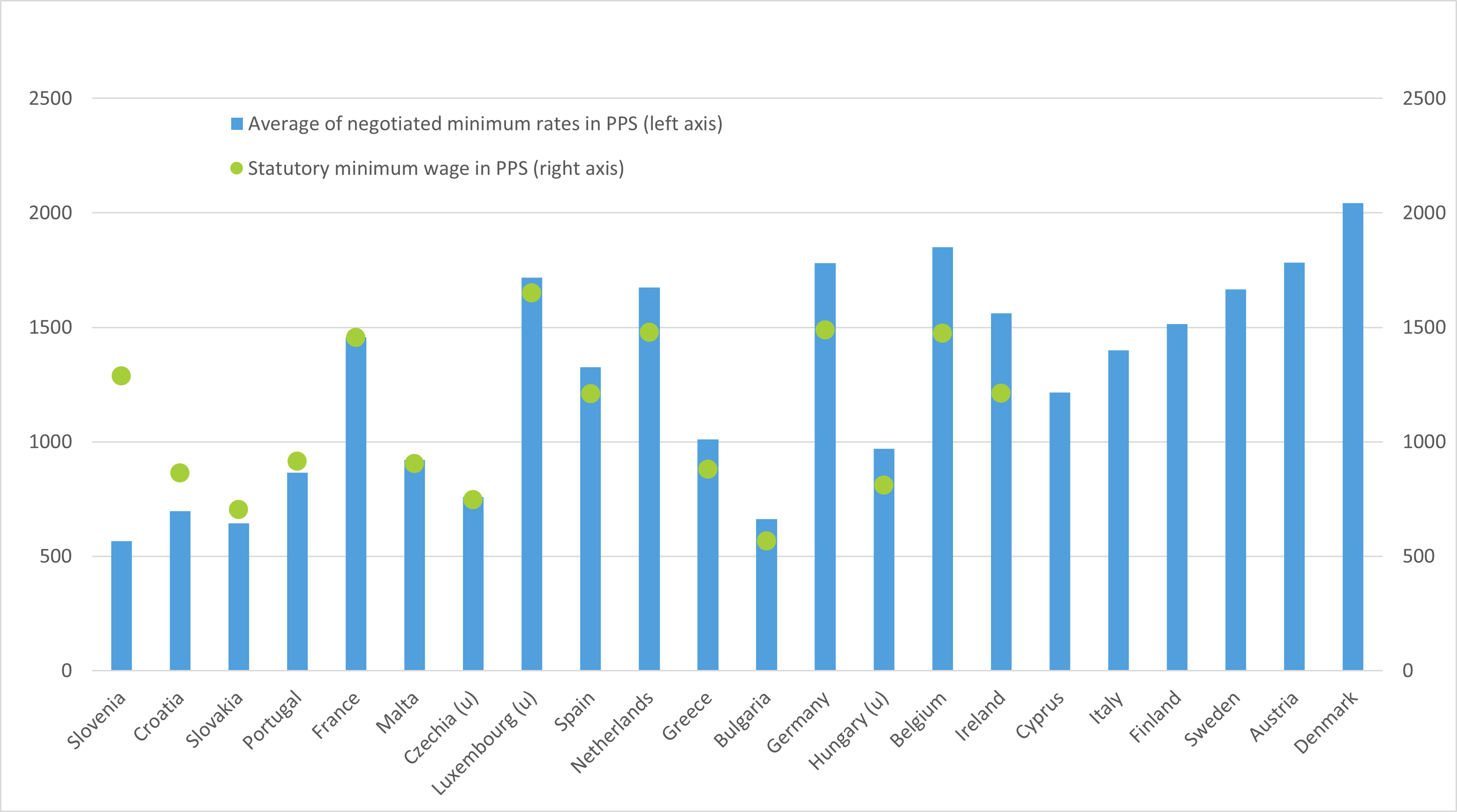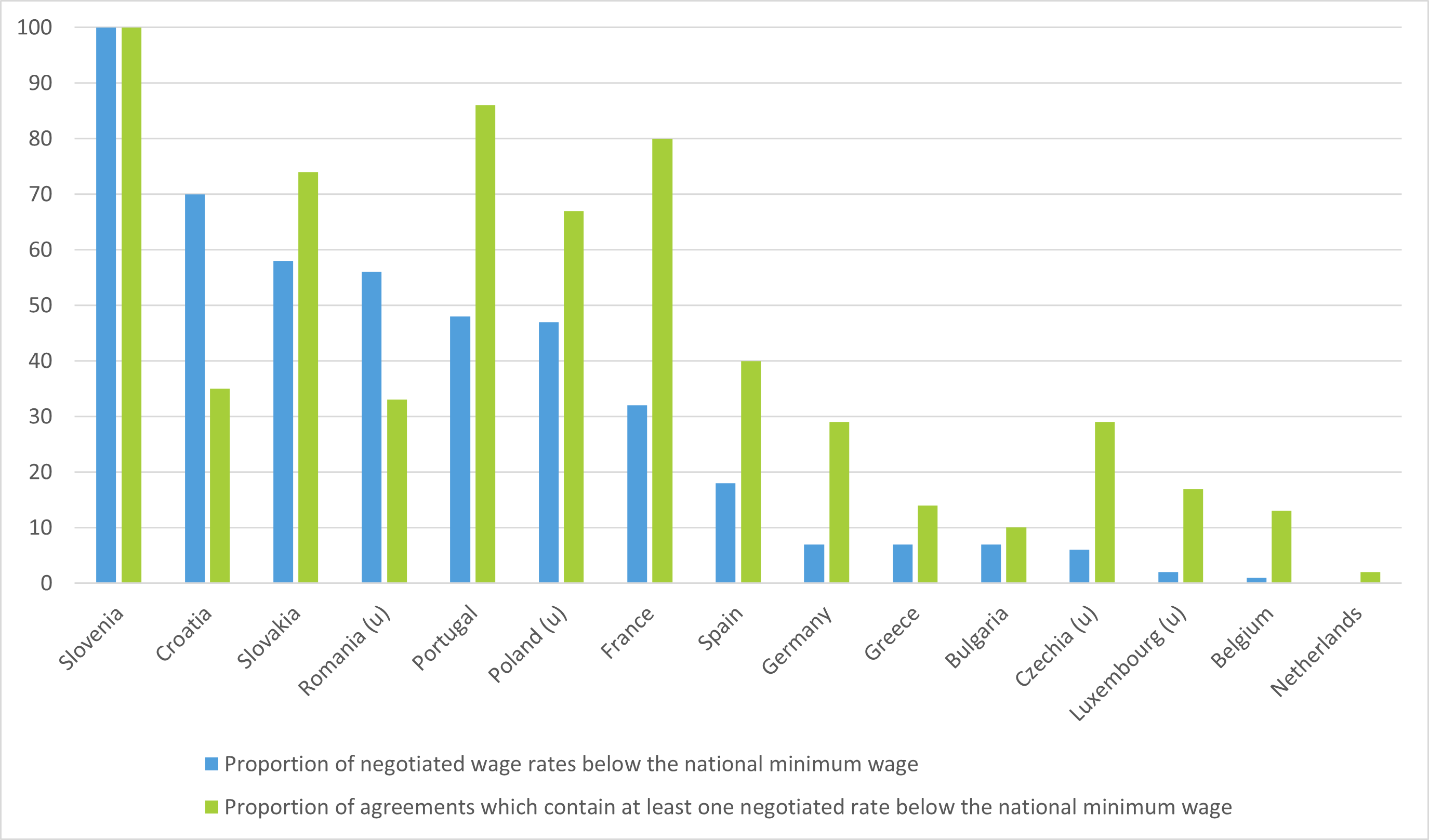Minimum wages in collective agreements for low-paid workers
To date, there has been no EU-wide comparable data on the actual levels of negotiated minimum wages. The objective of the project ‘Minimum wages in collective agreements for low-paid workers’ was to pilot the feasibility of setting up an EU-wide database of collective agreements related to low-paid workers and to provide estimates for minimum pay rates contained in these agreements.
For this purpose, 24 (NACE two-digit) sectors were selected on the basis that they were significant in terms of employment and included a substantial proportion of low-paid employees. Where available, collective agreements and their updated texts (dating from 2015 to 2022) were retrieved for these sectors. The data collection is thus based on more than 3,200 source texts related to 692 ‘fully coded’ collective agreements. In total, these agreements cover at least 43 million workers (excluding Germany, in particular, among the larger Member States, for which no such estimates on worker coverage are available).
Collectively agreed pay topping up national minimum wages
In each collective agreement, the central variable of interest is the lowest basic pay rate for an adult worker. However, only 85% of the selected agreements contain pay rates. Figure 1 shows the resulting country average of these negotiated minimum rates, expressed in purchasing power standard (PPS). In 11 of the 16 Member States that have national minimum wages and for which data are available, the lowest negotiated basic rate is higher than the national minimum wage (i.e. the minimum wage is topped up). In France, the average negotiated rate in the sample of selected agreements is virtually identical to the national minimum wage. However, in four Member States (Croatia, Portugal, Slovakia and Slovenia), the negotiated rates are below the national minimum wage. There may be different reasons for this. In Croatia, for example, the law states that agreements can go up to 5% below the legal minimum wage. In the case of the other countries, the negotiated minimum rate might not have been updated for a long period, some basic pay rates might not be in use any longer, or a different wage structure with top-ups to the basic rates to reach the national level could be used.
Figure 1: Negotiated minimum rates versus national minimum wages, monthly (€ and PPS)
Note: No (representative) data available for Estonia, Latvia, Lithuania, Poland or Romania. Figures for Malta relate to wage regulation orders. Monthly averages take into consideration that in some countries and agreements more than 12 monthly payments apply. [u], sample is unreliable.
Source: Eurofound’s database on minimum wages in collective agreements for low-paid workers
Outdated rates
A closer look at the issue of basic rates that are lower than the legal minimum wage shows that this phenomenon is not confined only to the four Member States mentioned above. Within the data collection, such instances were found in collective agreements concluded in 15 out of the 22 Member States with a national minimum wage. While this phenomenon is negligible in the Benelux countries and not very prevalent in Bulgaria, Germany and Greece, it is a significant issue in other countries. The number of agreements that include a negotiated minimum rate that falls below the national minimum wage, and the period of time that it remains at that level, depends on whether and how fast the agreements or pay rates are renegotiated. The average length of time during which a negotiated minimum rate remains below the national minimum wage varies: less than one year in the Benelux countries, between one and two years in Czechia and Germany, between two and four years in Bulgaria, France, Greece and Spain, and more than four years in the remaining countries plotted in Figure 2. All of these periods are based on the maximum duration of eight years, over which the sample was compiled.
Figure 2: Negotiated minimum rates below the national minimum wage among the sampled agreements (%)
Note: No (representative) data available for Estonia, Latvia, Lithuania, Poland or Romania. (u), sample is unreliable.
Source: Eurofound’s database on minimum wages in collective agreements for low-paid workers
Conclusions
The research shows that, in most cases, collective agreements (related to low-paid sectors) provide for a top-up of minimum pay vis-à-vis the national minimum wage; however, this is not always guaranteed. In some countries more than others, the (lowest basic) rates can be outdated and lower than the applicable minimum wage, sometimes for several years, and are thus not binding. In other cases, even if agreements exist, they do not regulate pay, or they only regulate pay for a few workers but not for those higher up the pay scale. All of these cases can be potentially foregone opportunities for the social partners – workers and employers – to have their sector- or company-specific say on pay. Situations where the national minimum wage becomes dominant and ‘crowds out’ collective (wage) bargaining should be avoided. Given the current political emphasis on increasing minimum wages, it will be important to closely monitor what will happen to collective (wage) bargaining for low-paid workers, and to ensure that collective bargaining continues to improve the wages and conditions of low-paid workers. Eurofound’s successfully piloted new data collection will be capable of doing just that.
Image © Jacob Lund/Adobe Stock


